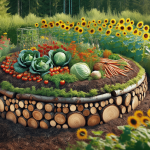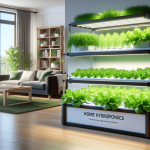This post may contain affiliate links. As an Amazon Associate, we may earn commissions from qualifying purchases.
Hey there! Have you ever wondered how you can make your land more efficient while promoting sustainability? “Utilizing Key-line Design Principles For Optimal Water Distribution And Soil Health” dives into transformative ways you can enhance your farm or garden’s water management. By strategically employing key-line design principles, you’ll not only maximize water retention but also improve soil structure, ensuring healthier plants and a more resilient environment. This method is all about working smarter, not harder, to achieve flourishing landscapes brimming with life. Have you ever wondered how you can improve water distribution and soil health on your property? Whether you are a farmer, gardener, or just someone interested in permaculture, key-line design principles can offer a transformative approach to managing landscapes. This method provides a sustainable way to address water scarcity, soil erosion, and fertility issues. In this comprehensive guide, we’ll delve into the intricacies of key-line design and how you can harness its benefits for your land.
What is Key-line Design?
Before diving into the practicalities, it’s essential to understand what key-line design is. Developed by Australian farmer and engineer P.A. Yeomans in the 1940s, key-line design is an integrated approach to land management aimed at maximizing beneficial use of water resources while enhancing soil health. The system focuses on understanding the natural contours and slopes of your land to optimize water distribution, thereby reducing erosion and improving soil fertility.
The Keyline and Keypoint Concept
At the heart of key-line design are two crucial concepts: the keyline and the keypoint. The keypoint is the place in a valley where the slope changes from concave to convex, usually where the soil can hold more moisture. The keyline, on the other hand, is a contour line extending from the keypoint across the landscape. Identifying these features is your first step towards effective key-line planning.
Historical Context and Development
To appreciate the relevance of key-line design, it’s helpful to understand its origins. P.A. Yeomans was motivated by the recurring droughts and soil erosion issues plaguing Australian agriculture. His observations led him to create a system that not only addressed these challenges but also leveraged natural rainfall more efficiently. Over the past decades, key-line design has gained traction globally, influencing modern permaculture practices and regenerative agriculture.

Core Principles of Key-line Design
The key-line design framework is built on several fundamental principles, each working synergistically to improve water distribution and soil health.
Principle 1: Contour Mapping
Contour mapping is the foundation of key-line design. It involves understanding the natural topography of your land through detailed surveys and maps.
How to Map Contours
- Survey Your Land: Use tools like GPS, A-frame levels, or laser levels to survey your land.
- Create a Contour Map: Plot the survey results to create a detailed map of your land’s contours.
- Identify Keypoints and Keylines: Mark these crucial features on your contour map.
Principle 2: Water Harvesting
Water harvesting involves capturing and storing rainwater to ensure a more consistent water supply throughout the year.
Techniques for Water Harvesting
- Swales: Ditches built on contour lines to capture and hold rainwater.
- Ponds: Strategic placement of ponds to collect rainwater, which can be used for irrigation during dry periods.
- Keyline Plowing: Plowing along keylines to create channels that direct water into the soil.
Principle 3: Soil Fertility and Structure
Healthy soil is the cornerstone of any sustainable agricultural practice. Key-line design incorporates strategies to improve soil fertility and structure.
Soil Improvement Techniques
- Composting: Adding organic matter to enrich the soil.
- Cover Cropping: Planting cover crops to prevent soil erosion and improve soil structure.
- Mulching: Using organic mulches to retain soil moisture and suppress weeds.
Principle 4: Biodiversity
Biodiversity enhances the resilience of your ecosystem, making it less susceptible to pests and diseases.
Enhancing Biodiversity
- Polyculture: Growing multiple crop species together.
- Integrated Pest Management (IPM): Using biological controls to manage pests.
- Habitat Creation: Planting hedgerows and creating habitats for beneficial insects and wildlife.
Steps to Implement Key-line Design on Your Land
Implementing key-line design requires a step-by-step approach to ensure all aspects are adequately covered.
Step 1: Preliminary Planning
Begin with a comprehensive assessment of your property’s topography, soil type, and existing vegetation. This initial planning phase will help you identify keypoints, keylines, and potential areas for water harvesting structures.
Step 2: Contour Mapping and Keyline Identification
With a detailed topographical map in hand, identify the keypoints and draw keylines across your property. This will guide the positioning of swales, ponds, and other water-harvesting systems.
Step 3: Developing Water Harvesting Systems
Focus on creating swales, ponds, and other structures that capture and store rainwater. Prioritize areas prone to erosion or water scarcity.
Step 4: Soil Improvement and Biodiversity
Work on enhancing soil fertility through composting, cover cropping, and mulching. Incorporate diverse plant species to promote a balanced ecosystem.
Step 5: Monitoring and Adjustment
Regularly monitor your land to assess the effectiveness of your key-line design strategies. Make adjustments as necessary based on observations and data.

Benefits of Key-line Design
Implementing key-line design offers multiple benefits, impacting both the environment and agricultural productivity.
Improved Water Management
By optimizing water distribution, key-line design ensures that rainwater is used efficiently, reducing the need for supplemental irrigation.
Enhanced Soil Fertility
Practices such as composting and cover cropping improve soil health, leading to higher crop yields and lower dependency on chemical fertilizers.
Reduced Soil Erosion
Key-line plowing and other soil management techniques reduce soil erosion, preserving valuable topsoil.
Resilience to Climate Change
A biodiverse and well-managed ecosystem is more resilient to the impacts of climate change, including extreme weather events.
Challenges and Limitations
Despite its numerous advantages, key-line design does come with some challenges and limitations.
Initial Investment
The initial costs of surveying, mapping, and constructing water harvesting structures can be significant.
Cost Breakdown Table
| Item | Estimated Cost |
|---|---|
| Topographical Survey | $500 – $2,000 |
| Contour Mapping Tools | $100 – $1,000 |
| Swale Construction | $500 – $5,000 |
| Pond Construction | $1,000 – $20,000 |
| Keyline Plow | $2,000 – $10,000 |
Knowledge and Skills
Successfully implementing key-line design requires a solid understanding of topography, hydrology, and soil science. This may necessitate additional training or consultation with experts.
Time and Labor
Building and maintaining key-line structures can be labor-intensive, particularly on large properties. It is essential to consider the long-term effort required to sustain these systems.
Case Studies and Real-World Applications
To provide a more tangible understanding of key-line design, let’s explore a few real-world applications and case studies.
Case Study 1: Zaytuna Farm, Australia
Zaytuna Farm, run by permaculture advocates Geoff and Nadia Lawton, exemplifies key-line design in action. By implementing swales, ponds, and keyline plowing, they transformed a degraded landscape into a fertile, productive farm.
Case Study 2: Taranaki Farm, New Zealand
Taranaki Farm in New Zealand employs key-line design principles to manage water and improve soil health. The farm uses a combination of swales, polyculture, and rotational grazing to maintain a balanced ecosystem.
Key-line Design in Urban Settings
While key-line design is often associated with rural farmland, its principles can also be applied in urban settings. For example, urban gardeners can use contour mapping and water harvesting techniques to improve water efficiency and soil health in their backyard gardens.
Urban Key-line Strategies
- Raised Beds: Build raised beds along contour lines to improve water infiltration and retention.
- Rain Gardens: Create rain gardens to capture and use stormwater runoff.
- Composting: Use kitchen scraps and yard waste to create nutrient-rich compost for your garden.
Tools and Resources
To successfully implement key-line design, you’ll need access to various tools and resources. Here are some essential items:
Surveying Tools
- GPS Devices: For accurate mapping of your property.
- A-Frame Levels/Laser Levels: To identify contours and slopes.
Construction Tools
- Shovels and Spades: Basic digging tools for creating swales and ponds.
- Keyline Plow: Specialized equipment for plowing along keylines.
Educational Resources
- Books: “Water for Every Farm” by P.A. Yeomans provides comprehensive insights into key-line design.
- Online Courses: Websites like Permaculture Design Course (PDC) offer online training on key-line design principles.
Common Myths and Misconceptions
Despite its proven benefits, key-line design is often misunderstood. Let’s debunk some common myths:
Myth 1: It’s Only for Large Farms
While key-line design is incredibly effective on large farms, its principles can be adapted for smaller properties and urban gardens.
Myth 2: It’s Too Expensive
Although there are initial costs associated with key-line design, the long-term benefits and reduced need for irrigation and chemical fertilizers often outweigh these expenses.
Myth 3: It Requires Expert Knowledge
While having expert knowledge is beneficial, many key-line design principles can be implemented by landowners with a basic understanding of topography and soil science.
Conclusion
Key-line design offers a sustainable, efficient approach to managing water and improving soil health. By leveraging the natural contours and features of your land, you can create a resilient, productive ecosystem. Whether you are managing a large farm or an urban garden, the principles of key-line design can help you make the most of your resources while contributing to a healthier environment.
So, are you ready to transform your landscape with key-line design? With the right planning, tools, and commitment, you can optimize water distribution and enhance soil health, setting the stage for long-term agricultural success.








